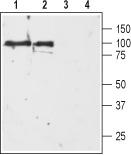Drd3 Rabbit Polyclonal Antibody
Other products for "Drd3"
Specifications
| Product Data | |
| Applications | IHC, WB |
| Recommended Dilution | WB: 1:200-1:2000; IHC: 1:100-1:3000 |
| Reactivities | Mouse, Rat |
| Host | Rabbit |
| Clonality | Polyclonal |
| Immunogen | Peptide CGAENSTGVNRARPH, corresponding to amino acid residues 15-29 of rat D3 Dopamine receptor. Extracellular, N-terminus. |
| Formulation | Lyophilized. Concentration before lyophilization ~0.8mg/ml (lot dependent, please refer to CoA along with shipment for actual concentration). Buffer before lyophilization: Phosphate buffered saline (PBS), pH 7.4, 1% BSA, 0.025% NaN3. |
| Purification | Affinity purified on immobilized antigen. |
| Conjugation | Unconjugated |
| Storage | Store at -20°C as received. |
| Stability | Stable for 12 months from date of receipt. |
| Gene Name | dopamine receptor D3 |
| Database Link | |
| Background | The D3 Dopamine Receptor (D3 receptor) is one of five receptors that mediate the effects of the catecholamine neurotransmitter dopamine. Dopamine regulates a variety of functions including locomotor activity, emotion, positive reinforcement, food intake, and endocrine regulation. The dopaminergic system has been extensively studied in the last thirty years mainly because its dysregulation has been linked to several neurological and neuropsychiatric diseases including Parkinsonâ??s disease and schizophrenia. All five dopamine receptors belong to the 7-transmembrane domain, G protein-coupled receptor (GPCR) superfamily. Historically, the five receptors have been divided into two subfamilies based on pharmacological and structural considerations: the D1-like subfamily (that includes the D1 and D5 subtypes) and the D2-like subfamily (that includes the D2-, D3- and D4 subtypes). The D1-like receptors are coupled to Gs-type G proteins and enhance adenylate cyclase activity while the D2-like receptors are coupled to Gi-type G proteins and inhibit adenylate cyclase activity. The D3 receptor distribution in the brain is relatively restricted to limbic areas such as striatum, islands of Calleja and olfactory tubercle. In the periphery, it is expressed in the kidney particularly in proximal tubules. The exact physiological function of the D3 receptor remains to be fully elucidated. In studies using D3 receptor knockout mice, the most prominent dysfunction was the development of rennin-dependent hypertension. Potential roles in reinforcement and reward behaviors have also been suggested as well as roles in neuropsychiatric disorders such as drug abuse and schizophrenia. |
| Synonyms | D3DR; ETM1; FET1; MGC149204; MGC149205 |
| Reference Data | |
Documents
| Product Manuals |
| FAQs |
{0} Product Review(s)
0 Product Review(s)
Submit review
Be the first one to submit a review
Product Citations
*Delivery time may vary from web posted schedule. Occasional delays may occur due to unforeseen
complexities in the preparation of your product. International customers may expect an additional 1-2 weeks
in shipping.






























































































































































































































































 Germany
Germany
 Japan
Japan
 United Kingdom
United Kingdom
 China
China





